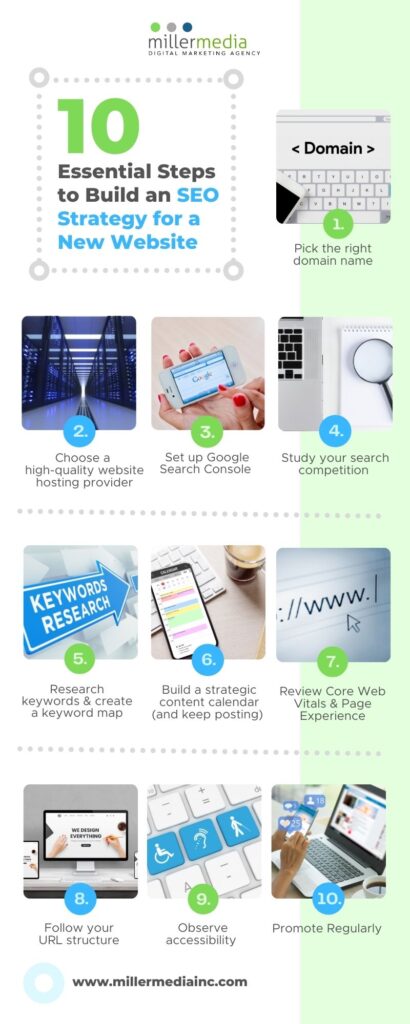
Here are 10 essential steps to build an SEO Strategy for your new website:
- Pick the right domain name
- Align your brand name with your domain name
- Choose a high-quality website hosting provider
- Your host’s speed impacts your site’s performance
- Set up Google Search Console
- Verify GSC so it collects important SEO performance data.
- Items to check regularly:
- Page speed issues
- Organic keywords that bring in website clicks
- Your average click through rate (CTR)
- Sitemap submission
- Crawl and index errors
- Page performance
- Study your search competition
- Identify companies who sells similar content, & have keyword rankings
- How is their company similar to yours?
- How is it different? Check out their unique selling points.
- What topics do they write about?
- What keywords are they already ranking for?
- Add your root domain vs your chosen competitor root domains
- Review the competitor overlap & shared keywords.
- Export into a spreadsheet & filter for the keywords that are relevant for your website.
- Research keywords & create a keyword map
- Cluster & map your keywords onto a spreadsheet
- Search intent & the buyer journey:
- Awareness stage > Consideration stage > Decision stage
- Does the keyword truly match my product or service?
- Does the keyword match questions that customers have asked (or might ask) throughout their buying journey?
- What is the keyword’s difficulty? (level of competition to rank for that keyword)
- What is the search volume of the keyword?
- What page types appear in the SERPs for this keyword?
- Build a strategic content calendar (and keep posting)
- Turn keyword map into your content
- Prioritize sections of your keyword map
- Optimize your content
- Track your keyword rankings
- Post consistently
- Turn keyword map into your content
- Follow your URL structure
- Stick to the URL structures you’ve outlined in the keyword map & use keywords in the URL
- Review Core Web Vitals & Page Experience
- Check if your website passes CWV & review users engagement metrics
- Observe accessibility
- Regularly review indexing issues & design your website with the appropriate font and image size.
- Include these items:
- Optimize alt text in images (for screen readers)
- Use enough contrast (make sure your colors are easy on the eye)
- Correctly label elements like buttons
- Make your font size big enough to read
- Promote Regularly
- Increase your SEO performance by promoting your content across other marketing channels.
- Think about paid traffic for the first few months
Overwhelmed? We can help! Call 248.528.3600

